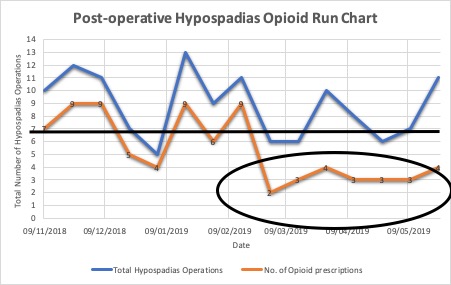Opioid stewardship in pediatric urology following outpatient hypospadias surgery - A quality improvement initiative
Fardod O'Kelly, MD MB MA FRCS(Urol), Martha Pokarowski, BSc MPH, Martin A. Koyle, MD MSc FRCSC FACS FAAP.
The Hospital for Sick Children, Toronto, ON, Canada.
Background
Over-prescription of paediatric opiate medications, particularly in the acute pain and post-surgical settings plays a significant role in opioid exposure trends and the development of opioid-related complications such as over-sedation in hospitalised patients. Prior reports illustrate wide opiate prescribing variability among paediatric surgical patients as well as gross post-operative medication surplus, with an incidence of persistent use 90-days post-surgery between 2.7-15.2%. There currently exists in our institution, significantly heterogenous postoperative opioid prescribing practices. The aim of this prospective quality improvement and patient safety study was to reduce post-operative opioid prescription in a day case hypospadias cohort by 30% over a 4 month period. The hypothesis was that a decrease in post-operative opioid prescription would not lead to an increase in adverse clinical outcomes following hypospadias surgery
Methods
Institutional quality improvement committee approval was obtained. Interventions included a mixture of qualitative and quantitative research through PDSA cycles and outcome measurements. These interventions were people-focused through education/training and reminders, and system-focused through simplification and forcing functions. There were no changes to intra-operative management by anesthesiology. Change management achieved through the alignment of stakeholder, education of parents (handouts/online atlas) and a core change team. ER visits, phone and email logs were recorded. Parents were also contacted within a fortnight post-operatively to assess for pain, satisfaction and analgesic requirements. This cohort was then compared to a similar group who had received opioids post-operatively.
Results
There were 54 patients in the intervention arm of this study (22 opioid; 32 non-opioid). The rate of opioid prescriptions decreased from an average of 74% (0-20 doses) to 42% representing an absolute reduction of 32% (relative reduction 44%) over a period of 3 months. This was not associated with any increase in adverse outcomes or unintended consequences as captured through balancing measures. There was a significant reduction in the rate of constipation post-operatively in the non-opioid (9.4% vs. 36.4%; p=0.035)
Conclusions
The implementation of a post-operative opioid-sparing approach to hypospadias is safe with no increase in clinical adverse outcomes for children. The relative reduction of 44% is modest but sustainable, and in line with several campaigns calling for a rationalisation in narcotic usage including Choosing Wisely. Challenges continue to exist in stakeholder engagement and leading practice change in order to ensure sustainability 
Back to 2019 Abstracts




